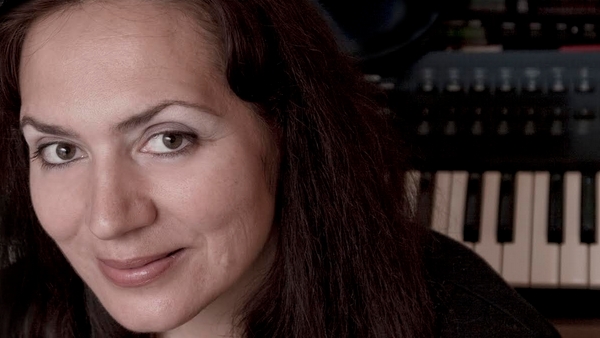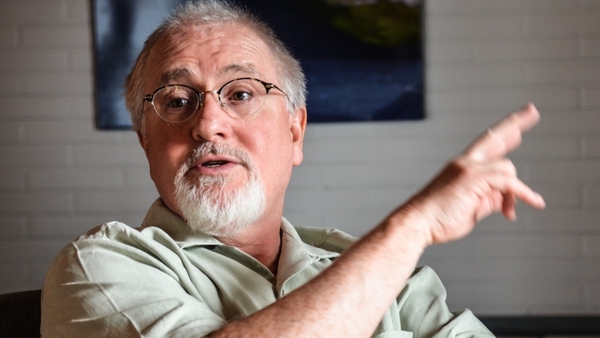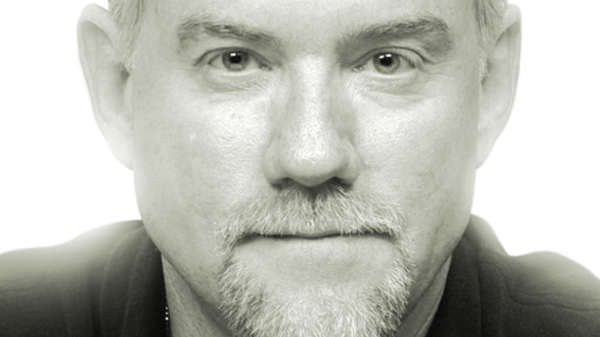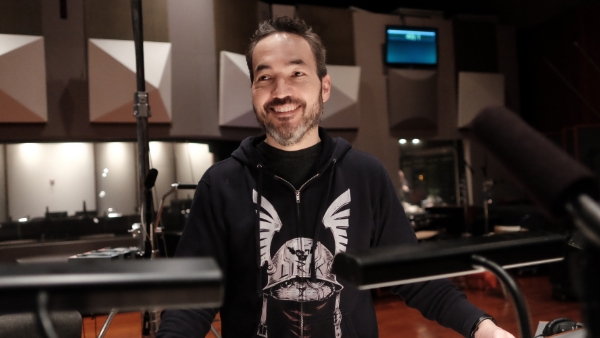 Film and game composer Penka Kouneva has worked for 15 years in Los Angeles on a variety of projects from games, to shorts, to feature films. Her own music is a blend of her Eastern-European upbringing, classical training, modern film & game music, and influences ranging from rock, electronica, Medieval chant to non-Western music. A woman composer role model on the vanguard of the rising momentum for women creatives in entertainment, Penka Kouneva made Hollywood history as the first woman Lead Orchestrator on films with a budget over $100M – Ender’s Game and Elysium. In various capacitites, she has had notable collaborations with the celebrity composers Hans Zimmer (orchestrator: Pirates 3, Angels and Demons), Steve Jablonsky (Transformers franchise, Gears of War 2, 3).
Film and game composer Penka Kouneva has worked for 15 years in Los Angeles on a variety of projects from games, to shorts, to feature films. Her own music is a blend of her Eastern-European upbringing, classical training, modern film & game music, and influences ranging from rock, electronica, Medieval chant to non-Western music. A woman composer role model on the vanguard of the rising momentum for women creatives in entertainment, Penka Kouneva made Hollywood history as the first woman Lead Orchestrator on films with a budget over $100M – Ender’s Game and Elysium. In various capacitites, she has had notable collaborations with the celebrity composers Hans Zimmer (orchestrator: Pirates 3, Angels and Demons), Steve Jablonsky (Transformers franchise, Gears of War 2, 3).
Her second album, The Woman Astronaut, is a personal, autobiographical journey of an ambitious, self-determined woman who has chosen a unique profession. Conceived in three acts, The Woman Astronaut takes listeners on an epic musical journey that explores the infinity of space and the reaches of the human experience itself — ambition, perseverance, love and destiny. Kouneva composed the album on a scale to accompany an epic sci-fi blockbuster and was produced with the Hollywood Studio Orchestra and top Los Angeles soloists.
Each track feels like a distinctive chapter in her story and the level of complexity to each theme is remarkable. She will be one to watch for sure, especially with the work she has done on her last album and work in the film and game industry. Enjoy the entirety of our time with Penka Kouneva.
GoSeeTalk: Penka, it’s exciting talking to you about this project because, as the staggering statistic states, there are fewer female composers than female astronauts. What do you think accounts for that? It’s always seemed like a boys club, but how have you seen things change in the last 15 years?
Penka Kouneva: For centuries composing has been viewed as “not a woman’s profession.” Without role models and without mentors it’s very hard for a woman to see it as a viable
vocation for a lifetime. Also, it takes long years of gestation and maturing before “real success happens”. In the entertainment industry things are even more complex. The entertainment business is a high-risk business and the producers must mitigate their risks. One way is to hire “proven” composers – only those with big credits and body of work.
Also, the only way for composers to grow is to “prove” themselves on a big job. The opportunity to work on bigger and bigger jobs has been mostly inaccessible to women film composers (with some exceptions). Things are changing slowly but surely. I am very hopeful for the future. In the last few years we’ve seen women film and game composers skyrocket, compose on big titles, create amazing scores and cultivate careers. Also, a number of veteran women composers have built spectacular careers that are just now becoming more visible to larger audiences.
The Woman Astronaut is touted as “autobiographical”, so that means you are part of this composition inside and out. But talk to us about how freeing, or terrifying, this was because it was all up to you. There were no treatments, dailies or concept photos given to spur you on like films or video games – it was just you, your imagination and limitless possibilities.
I was the lead Orchestrator on Ender’s Game which inspired me tremendously and I decided that the life journey of my woman astronaut will have 3 acts – adolescence, young adult and maturity, like in Ender’s Game. Then I decided that each act will have its own emotional scope and tone – ambition, excitement of exploration (adolescence), passion for achievement (young adult) and peaceful and dark tones for maturity. Every piece is based on a life memory, or experience, and a favorite musical memory that inspired it. The process was not scary at all; it took focus and discipline, and keeping the big vision at all times. And then there’s always a deadline.
Working with some of the titans of the industry you probably picked up a lot. I talked to James Newton Howard about his career before film and his big break was something that just happened. But others I’ve talked with, like Harry Gregson-Williams and Steve Jablonsky, made their bones doing this until one day getting their shot. So it seems like there’s always a lot of ground work being laid before someone finally gets recognized.
I’m immensely grateful for the 16 years in Hollywood working as a composer on indie projects and orchestrator on the biggest titles. It’s been a fantastic learning experience that I cherish. It gives me such great joy that I’ve been able to help so many, and to contribute to other composers’ success. The ground work is mandatory for a sustained success, as one’s willpower gets forged through challenges, and one’s artistic vision gets purified through learning and choosing one’s aesthetics, taste and passions.
It seems like you had complete creative freedom on The Woman Astronaut. Of course Kickstarter helped you fund it, but what limitations did you have? When did Varése Sarabande step in?
The limitations were: 45 minutes of music, the budget I had and the rigor of sticking to my concept, storyline and creative vision. Many pieces were revised extensively; others had 2, 3, even 4 earlier versions tossed out, until I finally “found” the last version that is now on the CD. The complete creative freedom for me is a rigorous process of thinking, writing, revising, getting feedback, and then fine-tuning some more. The album’s Music Director Victor Rodriguez provided invaluable feedback, critique and guidance. Then I had a big recording session to plan and produce. I invited Robert Townson, the head of Varese Sarabande at the recording and he liked the music.
You were inspired by a number of sources – a wide variety of influences but it results in a stunning album. Does it help to have a road map of things you like to say “I want that on my album“? Further, who or what has influenced you the most, or does that change all the time based on the people you work with and experiences you have?
As an artist, I’ve always based my work on my authentic emotions and life experiences and strived to elevate them to a universal level that will resonate with other people. Just like my first album [A Warrior’s Odyssey], The Woman Astronaut is also about perseverance, hope, ambition, destiny, love, death – the journey of life. For The Woman Astronaut, I had a clear road map, right from the start. The emotional arc (from innocence to wisdom, and from youth to maturity), the 3-act structure, the life journey – these conceptual ideas were set in stone right from the start, in the summer of 2013. Then it took 2 years to compose the music, because I had a variety of great jobs and commitments. But the vision for the album remained focused all along. All the influences are in my liner notes for the CD. It’s a long list of my favorite music since childhood and from my recent years in Hollywood. It is music which has touched me and brought me to tears.
The album is just amazing. The first track alone, “Earth”, is like a personal statement that should impress anyone who listens to it. But what is the gap between when you finish writing the music and then handing it to an orchestrator or soloist to take it from there?
I worked very closely with all my soloists. They are dear friends and their past work inspired me. I wrote their pieces thinking about their tone and style – Sara Andon playing the
mysterious, evocative fantasy music on “World of Warcraft,” Lili Haydn playing Indian music with Qawwali musicians (one of the big influences for “Earth” is Indian music-meets-Medieval Chant).
Each soloist received detailed instructions and a description about the piece, tone, emotions, and what I was trying to achieve. I always work like this with people – by giving them detailed guidance, support and also space to explore and express their own emotions through my music. The orchestrations happened very fast – I orchestrated together with my orchestration partner Larry Rench.
I really like the way many tracks build. They are all so complex, even something simple sounding like “Looking Up”. But each is layered very well, so talk to us about stems and adding to each track to really flesh it out.
I was aware of the form of each piece – song forms, classical forms, etc. and they were supposed to build so that each piece felt like a journey. I programmed the synths and worked closely with my cherished collaborative partner, the Music Producer Christopher Lord who crafted all the amazing sound-design synths and the space effects. The stems included orchestra, percussion, synth pads, pulsing synths, variety of synth effects, noise effects and even “a field recording” – I recorded a metal squeak made by a rusty playground swing and built four tracks around that spooky sound of grinding metal. It was audio processed, of course, and put to use in “Insomnia”, “Goodbyes”, “Siren” and “Taking Flight”.
Much of your career is from some very popular and big budget video game work. Do you feel that video games give you a lot more freedom and opportunity to experiment than film does?
I absolutely love scoring video games and hope to score many more and bigger games. Composing for games has made me the most happy and most creatively fulfilled because games are a great fantasy, the music is evocative, thematic and also because I love working with game developers. “Freedom” is how energized and inspired I’ve felt as a creative artist; otherwise game scoring has tons of technical rigor and specific requirements.
Music is a collaboration between many people and trades. For instance how does working with different disciplines, or like the track “Training” which you co-composed with Jeff Broadbent, help create such a full-bodied product like The Woman Astronaut?
I’ve worked with Jeff on trailers and I know his sound. “Training” was the first piece of the 2nd Act, “Flight School” and I wanted to instantly evoke military training. The sound had to be drastically different from the colorful and day-dreaming Act 1. So, I gave Jeff my orchestral stems and asked him to program elements from dubstep – harsh percussion, fat low synths and “downers” (the sliding low synths) to evoke a sci-fi training academy where rookies are pushed to their limit. The piece was also inspired by real-life bullies and hazing, so it’s harsh and fragmented. I gave the same conceptual instructions to my amazing recording and mixing engineer John Rodd – to make it as harsh, punchy and abrasive as possible.
What about the project stretched you the most as an artist? Any instruments, techniques or parts of the recording process that were new to you this time?
While all of it is based on my musical memories, I stirred new sounds, new musical ideas to make it an innovative project. For instance, “Earth” is inspired by Indian music, Medieval chant but also by Katy Perry and Mahler’s Symphony #1.
I hadn’t composed on a sci-fi or space project yet, so I wanted to do something I hadn’t done before –transcendental, personal music for a fantasy / sci-fi story. The only way to grow as an artist is to continually push myself and try new things.
Finally, it looks like the feedback on the album has been overwhelmingly positive. Do you have another project similar to this on the horizon? I bet you made a ton of new fans who will keep an eye out for your work. Has this opened the doors to anything you hadn’t expected?
Right now I am reaching out to colleagues and industry friends. I’m grateful for the phenomenal response. It’s a great honor and privilege to be a role model and inspiration.
Thanks to Penka for her time. The Woman Astronaut is available from Varése Sarabande (click here to check out the album on their website). It really took us by surprise and we could not recommend it enough. It is going to be one of our top albums of 2015 that’s for sure.


